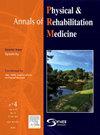各种运动干预对中枢致敏指标的比较有效性:系统综述和网络荟萃分析。
IF 4.6
3区 医学
Q1 REHABILITATION
Annals of Physical and Rehabilitation Medicine
Pub Date : 2025-01-15
DOI:10.1016/j.rehab.2024.101894
引用次数: 0
摘要
背景:中枢致敏(CS)增加肌肉骨骼疼痛。定量感觉测试(QST)或自我报告问卷可能表明CS。CS指标可能受到运动的抑制,但最佳运动方案尚不清楚。目的:我们进行了系统回顾和网络荟萃分析(NMA),以调查不同运动方案对成人这些CS指数的有效性。方法:检索自成立至2023年11月的6个电子数据库。随机对照试验(RCTs)的荟萃分析调查了运动对所有CS指标的影响。两名独立审稿人评估了偏倚风险。rct的NMA比较不同运动类型的CS指数。仅使用高质量的研究进行敏感性分析以验证我们结果的稳健性。采用GRADE方法评估确定性。结果:在249项符合条件的研究中,164项为随机对照试验,其中89项提供了适合NMA的数据。荟萃分析显示,与基线相比,干预后CS指数有很大改善(SMD -0.81, 95% CI -0.93至-0.70)。所有报告的运动类别,除了单独的伸展运动,都比不运动的对照组更有效。与非运动对照组相比,包括拉伸和强化运动(SMD -1.67, 95%可信区间(CrI) -2.41至-0.97),或强化、拉伸和有氧成分(SMD -1.61, 95%可信区间(CrI) -2.74至-0.56)的联合运动在降低CS指数方面最有效。敏感性分析证实了我们研究结果的稳健性,特别是对于联合拉伸和强化运动。结论:我们的荟萃分析表明,各种运动干预对改善CS是有效的。多组分运动往往是最有效的,但有些运动组合可能比其他更好。结合运动包括强化和拉伸部分,有或没有有氧运动,在其他组合中最有可能成为最佳运动类型。这些发现可能对未来的试验和针对CS患者的个性化治疗策略有帮助。本文章由计算机程序翻译,如有差异,请以英文原文为准。
Comparative effectiveness of various exercise interventions on central sensitisation indices: A systematic review and network meta-analysis
Background
Central sensitisation (CS) increases musculoskeletal pain. Quantitative sensory testing (QST) or self-report questionnaires might indicate CS. Indices of CS might be suppressed by exercise, although the optimal exercise regimen remains unclear.
Objectives
We conducted a systematic review and network meta-analysis (NMA) to investigate effectiveness of different exercise regimens on these CS indices in adults.
Methods
We searched 6 electronic databases from inception to November 2023. Meta-analysis of randomised controlled trials (RCTs) investigated effects of exercise on all CS indices. Two independent reviewers assessed risk of bias. NMA of RCTs compared CS indices between exercise types. Sensitivity analysis using only high-quality studies was performed to verify the robustness of our results. Certainty was assessed using the GRADE approach.
Results
Of the 249 eligible studies identified, 164 were RCTs, of which 89 provided data suitable for NMA. Meta-analysis revealed large improvement of post-intervention CS indices compared to baseline (SMD −0.81, 95 % CI −0.93 to −0.70). All reported categories of exercise, except stretching exercise alone, were more effective than non-exercise controls. Combined exercises that include stretching together with strengthening exercises (SMD −1.67, 95 % Credible Interval (CrI) −2.41 to −0.97), or strengthening, stretching and aerobic components (SMD −1.61, 95 % CrI −2.74 to −0.56) were most effective at reducing CS indices compared to non-exercise controls. Sensitivity analysis confirmed the robustness of our findings, particularly for combined stretching and strengthening exercise.
Conclusions
Our meta-analysis suggested that various exercise interventions are effective in improving CS. Multi-component exercise tends to be the most effective, but some exercise combinations might be better than others. Combined exercise featuring strengthening and stretching components, with or without aerobic exercise, shows the greatest likelihood among other combinations of being the optimal exercise type. These findings might have utility informing future trials and personalising treatment strategies for people with CS features.
求助全文
通过发布文献求助,成功后即可免费获取论文全文。
去求助
来源期刊

Annals of Physical and Rehabilitation Medicine
Medicine-Rehabilitation
CiteScore
7.80
自引率
4.30%
发文量
136
审稿时长
34 days
期刊介绍:
Annals of Physical and Rehabilitation Medicine covers all areas of Rehabilitation and Physical Medicine; such as: methods of evaluation of motor, sensory, cognitive and visceral impairments; acute and chronic musculoskeletal disorders and pain; disabilities in adult and children ; processes of rehabilitation in orthopaedic, rhumatological, neurological, cardiovascular, pulmonary and urological diseases.
 求助内容:
求助内容: 应助结果提醒方式:
应助结果提醒方式:


